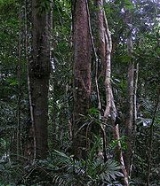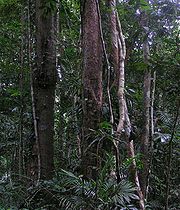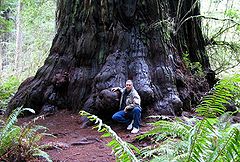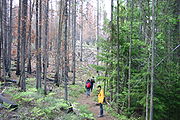
Forest ecology
Encyclopedia

Flora
Flora is the plant life occurring in a particular region or time, generally the naturally occurring or indigenous—native plant life. The corresponding term for animals is fauna.-Etymology:...
, fauna
Fauna
Fauna or faunæ is all of the animal life of any particular region or time. The corresponding term for plants is flora.Zoologists and paleontologists use fauna to refer to a typical collection of animals found in a specific time or place, e.g. the "Sonoran Desert fauna" or the "Burgess shale fauna"...
and ecosystem
Ecosystem
An ecosystem is a biological environment consisting of all the organisms living in a particular area, as well as all the nonliving , physical components of the environment with which the organisms interact, such as air, soil, water and sunlight....
s in forests. The management of forests is known as forestry
Forestry
Forestry is the interdisciplinary profession embracing the science, art, and craft of creating, managing, using, and conserving forests and associated resources in a sustainable manner to meet desired goals, needs, and values for human benefit. Forestry is practiced in plantations and natural stands...
, silviculture
Silviculture
Silviculture is the practice of controlling the establishment, growth, composition, health, and quality of forests to meet diverse needs and values. The name comes from the Latin silvi- + culture...
, and forest management
Forest management
200px|thumb|right|[[Sustainable development|Sustainable]] forest management carried out by [[Complejo Forestal y Maderero Panguipulli|Complejo Panguipulli]] has contributed to the preservation of the forested landscape around [[Neltume]], a sawmill town in Chile...
. A forest ecosystem is a natural woodland unit consisting of all plants, animals and micro-organisms (Biotic component
Biotic component
Biotic components are the living things that shape an ecosystem. A biotic factor is any living component that affects another organism, including animals that consume the organism in question, and the living food that the organism consumes. Each biotic factor needs energy to do work and food for...
s) in that area functioning together with all of the non-living physical (abiotic) factors of the environment.
Relationship to other branches of ecology

Categorization
Categorization is the process in which ideas and objects are recognized, differentiated and understood. Categorization implies that objects are grouped into categories, usually for some specific purpose. Ideally, a category illuminates a relationship between the subjects and objects of knowledge...
of types of ecological study (as opposed to a classification based on organizational level or complexity, for example population
Population ecology
Population ecology is a sub-field of ecology that deals with the dynamics of species populations and how these populations interact with the environment. It is the study of how the population sizes of species living together in groups change over time and space....
or community ecology). Thus, forests are studied at a number of organizational levels, from the individual organism
Organism
In biology, an organism is any contiguous living system . In at least some form, all organisms are capable of response to stimuli, reproduction, growth and development, and maintenance of homoeostasis as a stable whole.An organism may either be unicellular or, as in the case of humans, comprise...
to the ecosystem. However, as the term forest
Forest
A forest, also referred to as a wood or the woods, is an area with a high density of trees. As with cities, depending where you are in the world, what is considered a forest may vary significantly in size and have various classification according to how and what of the forest is composed...
connotes an area inhabited by more than one organism
Organism
In biology, an organism is any contiguous living system . In at least some form, all organisms are capable of response to stimuli, reproduction, growth and development, and maintenance of homoeostasis as a stable whole.An organism may either be unicellular or, as in the case of humans, comprise...
, forest ecology most often concentrates on the level of the population
Population
A population is all the organisms that both belong to the same group or species and live in the same geographical area. The area that is used to define a sexual population is such that inter-breeding is possible between any pair within the area and more probable than cross-breeding with individuals...
, community
Community
The term community has two distinct meanings:*a group of interacting people, possibly living in close proximity, and often refers to a group that shares some common values, and is attributed with social cohesion within a shared geographical location, generally in social units larger than a household...
or ecosystem. Logically, tree
Tree
A tree is a perennial woody plant. It is most often defined as a woody plant that has many secondary branches supported clear of the ground on a single main stem or trunk with clear apical dominance. A minimum height specification at maturity is cited by some authors, varying from 3 m to...
s are an important component of forest research, but the wide variety of other life forms and abiotic components
Abiotic components
In biology and ecology, abiotic components are non-living chemical and physical factors in the environment which affect ecosystems. Abiotic phenomena underlie all of biology. Abiotic factors, while generally downplayed, can have enormous impact on ramonds evolution...
in most forests means that other elements, such as wildlife
Wildlife
Wildlife includes all non-domesticated plants, animals and other organisms. Domesticating wild plant and animal species for human benefit has occurred many times all over the planet, and has a major impact on the environment, both positive and negative....
or soil
Soil
Soil is a natural body consisting of layers of mineral constituents of variable thicknesses, which differ from the parent materials in their morphological, physical, chemical, and mineralogical characteristics...
nutrients, are often the focal point. Thus, forest ecology
Ecology
Ecology is the scientific study of the relations that living organisms have with respect to each other and their natural environment. Variables of interest to ecologists include the composition, distribution, amount , number, and changing states of organisms within and among ecosystems...
is a highly diverse and important branch of ecological study.
Forest ecology studies share characteristics and methodological approaches with other areas of terrestrial plant
Terrestrial plant
A terrestrial plant is one that grows on land. Other types of plants are aquatic , epiphytic , lithophytes and aerial ....
ecology. However, the presence of trees makes forest ecosystems and their study unique in numerous ways.
Community diversity and complexity
Since trees grow to much larger sizes than other plant life-forms, there is the potential for a wide variety of forest structures (or physiognomies). The infinite number of possible spatial arrangements of trees of varying size and species makes for a highly intricate and diverse micro-environment in which environmental variables such as solar radiation, temperature, relative humidityRelative humidity
Relative humidity is a term used to describe the amount of water vapor in a mixture of air and water vapor. It is defined as the partial pressure of water vapor in the air-water mixture, given as a percentage of the saturated vapor pressure under those conditions...
, and wind speed
Wind speed
Wind speed, or wind velocity, is a fundamental atmospheric rate.Wind speed affects weather forecasting, aircraft and maritime operations, construction projects, growth and metabolism rate of many plant species, and countless other implications....
can vary considerably over large and small distances. In addition, an important proportion of a forest ecosystem's biomass
Biomass (ecology)
Biomass, in ecology, is the mass of living biological organisms in a given area or ecosystem at a given time. Biomass can refer to species biomass, which is the mass of one or more species, or to community biomass, which is the mass of all species in the community. It can include microorganisms,...
is often underground, where soil structure, water quality
Water quality
Water quality is the physical, chemical and biological characteristics of water. It is a measure of the condition of water relative to the requirements of one or more biotic species and or to any human need or purpose. It is most frequently used by reference to a set of standards against which...
and quantity, and levels of various soil nutrients can vary greatly. Thus, forests are often highly heterogeneous environments compared to other terrestrial plant
Terrestrial plant
A terrestrial plant is one that grows on land. Other types of plants are aquatic , epiphytic , lithophytes and aerial ....
communities. This heterogeneity in turn can enable great biodiversity of species of both plants and animals. It also affects the design of forest inventory
Forest inventory
Forest inventory is the systematic collection of data and forest information for assessment or analysis. It is also commonly known as timber cruising. It is important for owners to cruise the timber to get an estimate of the value and possible uses of the timber...
sampling strategies, the results of which are sometimes used in ecological studies. A number of factors within the forest affect biodiversity; primary factors enhancing wildlife abundance and biodiversity are the presence of diverse tree species within the forest and the absence of even aged timber management. For example, the Wild turkey
Wild Turkey
The Wild Turkey is native to North America and is the heaviest member of the Galliformes. It is the same species as the domestic turkey, which derives from the South Mexican subspecies of wild turkey .Adult wild turkeys have long reddish-yellow to grayish-green...
thrives when uneven heights and canopy variations exist and its numbers are diminished by even aged timber management.
Energy flux

Potential energy
In physics, potential energy is the energy stored in a body or in a system due to its position in a force field or due to its configuration. The SI unit of measure for energy and work is the Joule...
that can be converted to kinetic energy
Kinetic energy
The kinetic energy of an object is the energy which it possesses due to its motion.It is defined as the work needed to accelerate a body of a given mass from rest to its stated velocity. Having gained this energy during its acceleration, the body maintains this kinetic energy unless its speed changes...
under the right circumstances. Two such conversions of great importance are fires and treefall
Windthrow
In forestry, windthrow refers to trees uprooted or broken by wind. Breakage of the tree bole instead of uprooting is sometimes called windsnap.- Causes :...
s, both of which radically alter the biota
Biota (ecology)
Biota are the total collection of organisms of a geographic region or a time period, from local geographic scales and instantaneous temporal scales all the way up to whole-planet and whole-timescale spatiotemporal scales. The biota of the Earth lives in the biosphere.-See...
and the physical environment where they occur. Also, in forests of high productivity, the rapid growth of the trees themselves induces biotic and environmental changes, although at a slower rate and lower intensity than relatively instantaneous disturbances such as fires.
Death and regeneration
Woody material, often referred to as coarse woody debrisCoarse woody debris
Coarse woody debris is a term used in English-speaking countries for fallen dead trees and the remains of large branches on the ground in forests. Some prefer the term coarse woody habitat . A dead standing tree is known as a snag and provides many of the same functions as coarse woody debris...
, decay
Decomposition
Decomposition is the process by which organic material is broken down into simpler forms of matter. The process is essential for recycling the finite matter that occupies physical space in the biome. Bodies of living organisms begin to decompose shortly after death...
s relatively slowly in many forests in comparison to most other organic
Organic matter
Organic matter is matter that has come from a once-living organism; is capable of decay, or the product of decay; or is composed of organic compounds...
materials, due to a combination of environmental factors and wood chemistry (see lignin
Lignin
Lignin or lignen is a complex chemical compound most commonly derived from wood, and an integral part of the secondary cell walls of plants and some algae. The term was introduced in 1819 by de Candolle and is derived from the Latin word lignum, meaning wood...
). Trees growing in arid
Arid
A region is said to be arid when it is characterized by a severe lack of available water, to the extent of hindering or even preventing the growth and development of plant and animal life...
and/or cold environments do so especially slowly. Thus, tree trunks and branches can remain on the forest floor for long periods, affecting such things as wildlife habitat
Habitat
* Habitat , a place where a species lives and grows*Human habitat, a place where humans live, work or play** Space habitat, a space station intended as a permanent settlement...
, fire behavior, and tree regeneration processes.
Water
Lastly, forest trees store large amounts of water because of their large size and anatomical/physiological characteristics. They are therefore important regulators of hydrological processes, especially those involving groundwater hydrologyHydrology
Hydrology is the study of the movement, distribution, and quality of water on Earth and other planets, including the hydrologic cycle, water resources and environmental watershed sustainability...
and local evaporation and rainfall/snowfall
Precipitation (meteorology)
In meteorology, precipitation In meteorology, precipitation In meteorology, precipitation (also known as one of the classes of hydrometeors, which are atmospheric water phenomena is any product of the condensation of atmospheric water vapor that falls under gravity. The main forms of precipitation...
patterns. Thus, forest ecological studies are sometimes closely aligned with meteorological
Meteorology
Meteorology is the interdisciplinary scientific study of the atmosphere. Studies in the field stretch back millennia, though significant progress in meteorology did not occur until the 18th century. The 19th century saw breakthroughs occur after observing networks developed across several countries...
and hydrological studies in regional ecosystem or resource planning studies. Perhaps more importantly the duff or leaf litter can form a major repository of water storage. When this litter is removed or compacted (e.g. through grazing or human overuse), erosion and flooding are exacerbated as well as deprivation of dry season water for forest organisms.
See also
- ClearcuttingClearcuttingClearcutting, or clearfelling, is a controversial forestry/logging practice in which most or all trees in an area are uniformly cut down. Clearcutting, along with shelterwood and seed tree harvests, is used by foresters to create certain types of forest ecosystems and to promote select species that...
- Close to nature forestryClose to nature forestryClose to nature forestry is a theory and practice that takes the forest as an ecosystem and manages it as such. It is based in reduced human intervention, that should be directed to accelerate the processes that nature would do by itself more slowly. It aims at overcoming the divorce between...
- Intact forest landscapes
- Old Growth forestOld growth forestAn old-growth forest is a forest that has attained great age , and thereby exhibits unique ecological features. An old growth forest has also usually reached a climax community...

